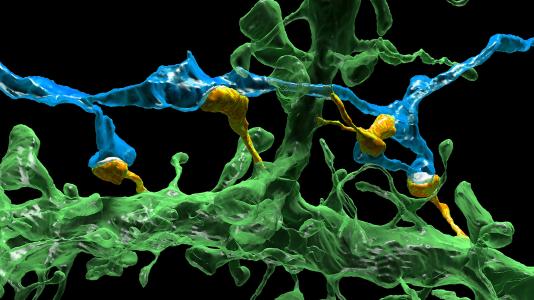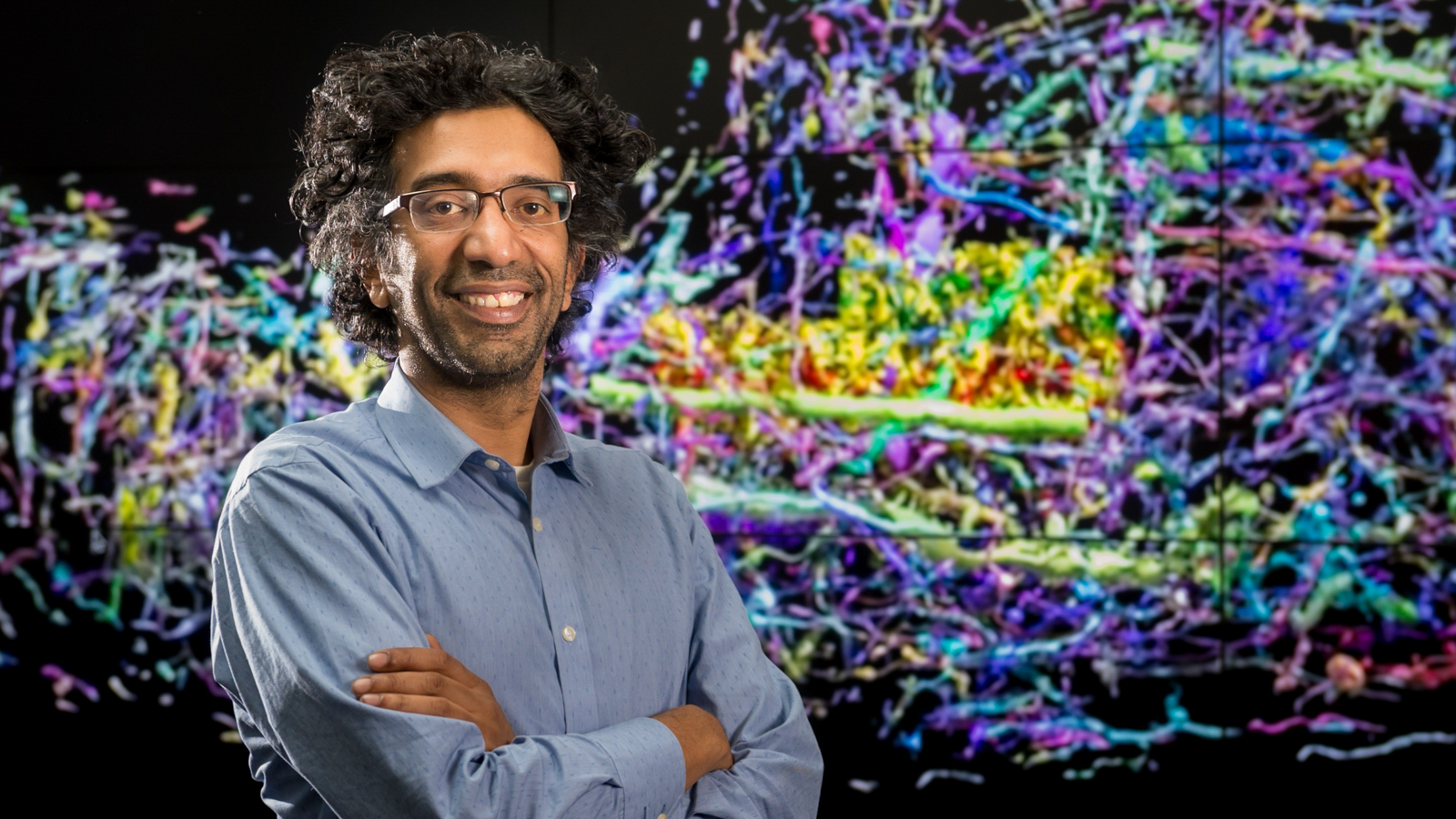
All 100 billion of them — or maybe 80 billion. Or maybe 120 billion?
“See, that’s the thing,” Kasthuri said. “Nobody actually knows how many neurons are in a brain.”
Despite centuries of study, including the genomics revolution in biology over the past 40 years, the human brain remains the proverbial black box. We don’t even have a complete picture of it; there are so many cells packed inside a brain that no one has ever actually gone over a brain and picked out each individual neuron and which ones it connects to. This is a tremendous gap in our knowledge of the brain, Kasthuri said, and though a complete map is still far away at this point, he wants to take the steps to get there.
“The idea is to have a synapse-level map of the brain, where every connection, and every cell that makes that connection, is mapped,” he said.
This is why he’s the first neuroscientist at the U.S. Department of Energy’s (DOE’s) Argonne National Laboratory, where he came because of another truth in brain research: it tends to get a boost when we discover some other unrelated technology. “Historically, the big discoveries happen when someone invents the microscope or adapts something from another field, and then we think to apply it to the brain — and, lo and behold, we discover something no one’s thought of before,” Kasthuri said.
“So I’m interested in places that are technology-driven, have large engineering and physics resources, and large computational resources: Argonne is perfect for all those reasons,” he said.
Kasthuri started with mouse brains, since they are similar to humans’ in many ways but conveniently smaller. To map it, he takes an entire mouse brain and stains it with dyes for contrast, embeds it in plastic and slices off atomically-thin layers that go into an electron microscope. Then the images are piled into a computer program to recreate the entire brain in 3D.
In a mouse brain, this is painstaking enough; a human brain is so much larger that with the current method, even if we could figure out a way around the technical issues like how to stain and plasticize it all the way through, characterizing even a single brain could take close to 50 years.
“It turns out that even at relatively low resolution, a whole brain is some crazy amount of data, like 700,000 or a million gigabytes. That’s more than all of the information in the Library of Congress right now.”
It’s because of this that Kasthuri is also interested in the Advanced Photon Source (APS) , a giant, powerful X-ray synchrotron on Argonne’s campus, including the nanoprobe beamline shared with the Center for Nanoscale Materials, both DOE Office of Science User Facilities.
“We’re testing at the APS, and we think it will let us map the entire brain without having to cut it or slice it or deform it — and to possibly do it very fast — which is crazy,” Kasthuri said. “With a method like that we could do multiple brains, so that we could see the variance between them.”
At intensities low enough not to damage the sample, the resolution provided by the APS is not quite as good as an electron microscope, but Kasthuri said they could combine methods. “We could conceivably use the APS to get a big map of the whole brain and then use the microscope to trace the wires in the most interesting part,” he said.
All of this imaging racks up huge quantities of data, which Argonne is also uniquely prepared to handle.
“It turns out that even at relatively low resolution, a whole brain is some crazy amount of data, like 700,000 or a million gigabytes,” he said. “That’s more than all of the information in the Library of Congress right now.”
Few academic labs in the world are set up to handle that kind of data, but that’s exactly what the supercomputing facilities at Argonne and other national labs are preparing for as they push the boundaries of computing towards exascale.
The task will also require sophisticated algorithms to sift through the data, identify neurons and map them across image planes to extract patterns and principles. “They’ve done this for a very simple organism, a small worm called C. elegans, and to a person it just looks like a mess,” Kasthuri said. “But a computer can find patterns that my visual system is overwhelmed by.”
Once completed, maps of the brain could shed light on many different questions about brains.
Kasthuri is particularly interested in how brains develop: “In mammals, particularly humans, babies are born essentially knowing nothing, and then we all grow into adults that master our environments and learn all these skills,” he said. “And most of these skills have no genetic sequence for them. There’s no DNA sequence for using an iPhone, driving a car, riding a bike, most of these things we do every day.” He wants to understand how brains change as they mature to adopt these kinds of skills.
Kasthuri is located in the Nanoscience and Technology division at Argonne, where he says in virtually every office is a nanoscientist working on techniques and technology that could offer new gateways to understanding the brain.
“It’s somewhere between exhilarating and terrifying, but it’s a really unique opportunity that I’m able to have,” Kasthuri said. “The scientists here are really interested in the physical limits. Like, does physics say we can do this or not do this, because once physics says we can do this, we’ll find the engineering to make it happen. This place is so much fun.”
The research is supported by the Intelligence Advanced Research Projects Activity and the National Institutes of Health.
Argonne National Laboratory seeks solutions to pressing national problems in science and technology. The nation’s first national laboratory, Argonne conducts leading-edge basic and applied scientific research in virtually every scientific discipline. Argonne researchers work closely with researchers from hundreds of companies, universities, and federal, state and municipal agencies to help them solve their specific problems, advance America’s scientific leadership and prepare the nation for a better future. With employees from more than 60 nations, Argonne is managed by UChicago Argonne, LLC for the U.S. Department of Energy’s Office of Science.
The U.S. Department of Energy’s Office of Science is the single largest supporter of basic research in the physical sciences in the United States and is working to address some of the most pressing challenges of our time. For more information, visit the Office of Science website.
